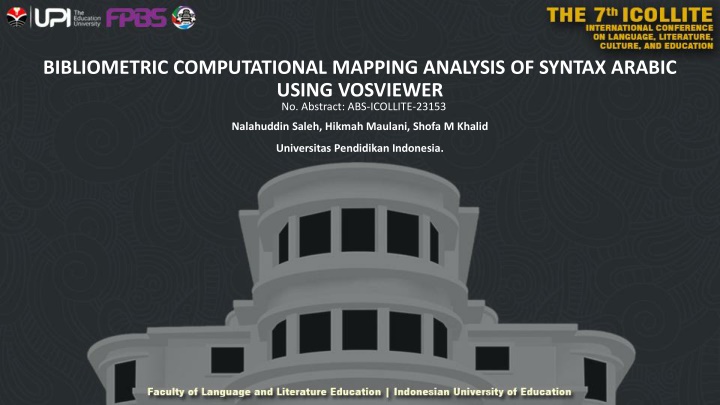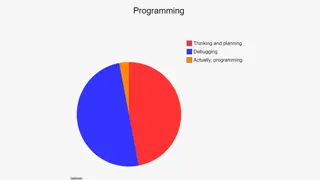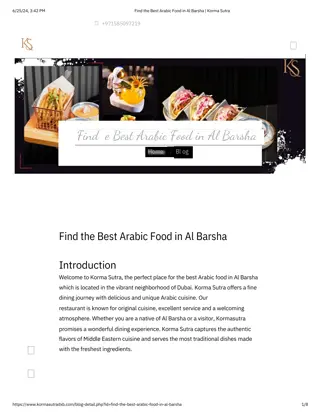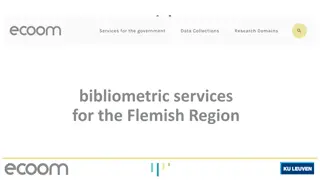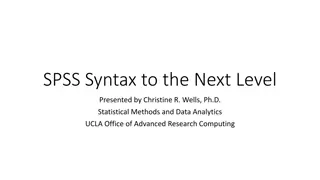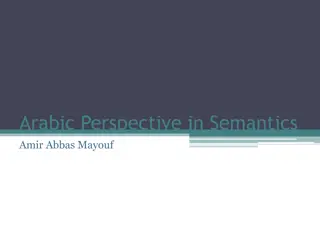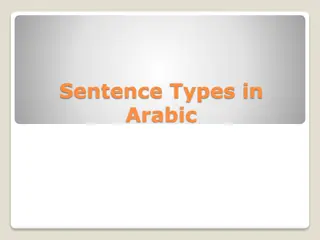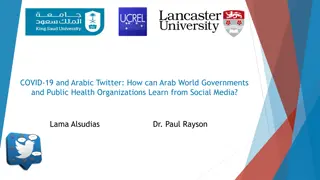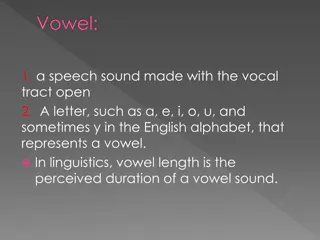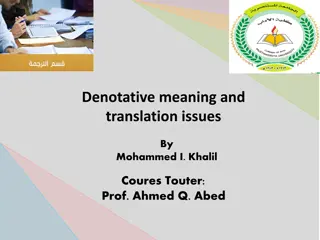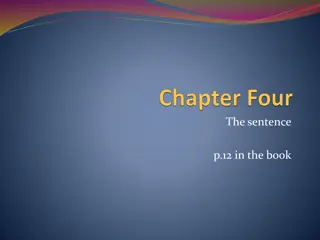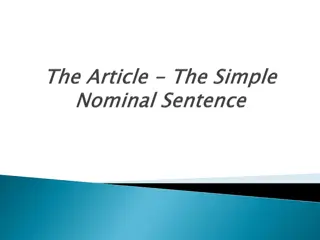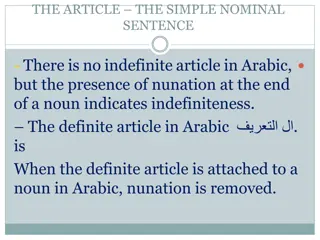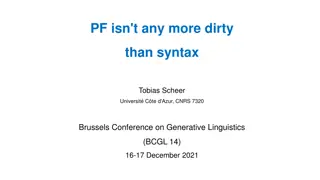Bibliometric Analysis of Arabic Syntax Using VOSviewer
This study explores the development of Arabic syntax research through a bibliometric approach with computational mapping analysis using VOSviewer. The literature review delves into the uniqueness of the Arabic language and its syntactic elements. The methodology involves data collection from Google Scholar indexed journals using the Publish or Perish reference manager application. The findings and discussions highlight the retrieval of 960 articles meeting the research criteria, with a focus on the top 30 most cited articles.
Download Presentation

Please find below an Image/Link to download the presentation.
The content on the website is provided AS IS for your information and personal use only. It may not be sold, licensed, or shared on other websites without obtaining consent from the author.If you encounter any issues during the download, it is possible that the publisher has removed the file from their server.
You are allowed to download the files provided on this website for personal or commercial use, subject to the condition that they are used lawfully. All files are the property of their respective owners.
The content on the website is provided AS IS for your information and personal use only. It may not be sold, licensed, or shared on other websites without obtaining consent from the author.
E N D
Presentation Transcript
BIBLIOMETRIC COMPUTATIONAL MAPPING ANALYSIS OF SYNTAX ARABIC USING VOSVIEWER No. Abstract: ABS-ICOLLITE-23153 Nalahuddin Saleh, Hikmah Maulani, Shofa M Khalid Universitas Pendidikan Indonesia.
INTRODUCTION This study discusses the development of Arabic syntax research with a bibliometric approach with computational mapping analysis using the Vos viewer. Article data obtained from the Google Scholar database using the publish or perish reference manager application. In the search process we use the keyword "Arabic Syntax. to find out the development of research in the field of Arabic syntax, one can use a tool, namely bibliometric analysis. Bibliometric analysis is a form of meta-analysis of research data that can assist researchers in studying bibliographic content and citation analysis of articles published in journals and other scientific works in recent times. the Arabic syntax has not been researched on computational mapping of bibliometric analysis. Especially bibliometric analysis for research in the last 10 years in the period 2012 to 2022 through the VOSviewer application.
LITERATURE REVIEW Arabic is categorized as a different language from other languages, Arabic has its own letters in addition to the Latin alphabet, namely hijaiyah letters. In this regard, the syntax of the Arabic language is about Arabic words in terms of their i'rab and bina', namely from what side they face in the state the words are composed. We also know what must happen from the final vowel of a word, from rafa ', nashab, jar or jazm, or still in a situation after the word is arranged in a sentence. The uniqueness of letters from Arabic, also touches on the complexity of its syntactic elements. Arabic is very rich and difficult, because of its structure and possibilities. Arabic script is written from right to left. It starts from the rightmost position of the page to the left in a cursive manner. Arabic alphabet consists of 28 basic characters
METHOD The article data used in this study is based on research from publications that have been published in Google Scholar indexed journals. We chose Google Scholar in this study because the Google Scholar database is open source compared to other paid or locked databases. To obtain research data, a reference manager application, namely Publish or Perish, is used. Publish or Perish software is used to conduct a literature review on our chosen topic with a selection of the last 10 years starting from 2012 to 2022
FINDING AND DISCUSSION Based on data searching through the publish or perish application reference manager from the Google Scholar database, 960 data articles were obtained that met the research criteria. The data obtained in the form of article metadata consisting of the author's name, title, year, journal name, publisher, number of citations, article links, and related URLs. The data samples taken were the 30 best articles that had the highest number of citations. The number of citations from all articles used in this study is 8933, the number of citations per year is 893.30, the number of citations per article is 9.12, the average author in the articles used is 2.11, all articles have an average h-index is 42, and the g-index is 67
Development of Arabic Syntax Research Year 2012 2013 2014 2015 2016 2017 2018 2019 2020 2021 2022 Total Number of Publication 52 55 69 83 103 73 73 87 136 147 82 960 The development of Arabic syntax research also fluctuated from 2016 to 2019, in 2016 as many as 103 articles, in 2017 and 2018 as many as 73 articles, in 2019 as many as 87 articles. Before finally experiencing a drastic increase again in the last 3 years, namely in 2020 as many as 136 articles, 2021 as many as 147 articles, and in 2022 there was a decline again to 82 articles.
Visualization of the Arabic Syntax field using Visualization of the Arabic Syntax field using VOSviewer VOSviewer Computational mapping was carried out on article data. VOSviewer is used in computational mapping. From the results of computational mapping found 244 items. Each item found related to Arabic syntax in data mapping is divided into 10 clusters
CONCLUSION The purpose of this study is to examine the development of Arabic syntax through a bibliometric approach for computational mapping analysis using Vos Viewer. Article data obtained from the Google Scholar database using the publish or perish reference manager application. In the search process we use the keyword "Arabic Syntax". Found 960 articles that are considered relevant. The study period used as study material is Google Scholar indexed articles for the last 10 years (2012 to 2022). The results showed that the Arabic syntax research can be separated into 3 terms: Syntax, Arabic, and science. The term "Syntax" is associated with 239 links with a total link strength of 3003. The term "Arabic" has 238 links with a total link strength of 2177 and the term "Science" has 227 links with a total link strength of 1615. Results of developmental analysis on Arabic syntax research in the last 10 years showed quite frequent fluctuations. In 2012-2016 it increased from 52 in 2012 to 103 in 2016. In 2016-2022 there were quite significant fluctuations. Meanwhile, the most research on Arabic syntax was carried out in 2021, which was 147 studies. We examined how many articles have been published on Arabic syntax and its relation to the use of VOSviewer
REFERENCES Aoun, J. E., Benmamoun, E., & Choueiri, L. (2009). The syntax of Arabic. Cambridge University Press. Aria, M., & Cuccurullo, C. (2017). bibliometrix: An R-tool for comprehensive science mapping analysis. Journal of informetrics, 11(4), 959-975. Chertow, M. R., Kanaoka, K. S., & Park, J. (2021). Tracking the diffusion of industrial symbiosis scholarship using bibliometrics: Comparing across Web of Science, Scopus, and Google Scholar. Journal of Industrial Ecology, 25(4), 913-931. El Zarka, D. (2012). One a many meanings. Syntax, semantics and prosody of the Moroccan modal particle a and its Egyptian Arabic counterparts. STUF 65(4). doi:10.1524/stuf.2012.0026 Farah, N., Souici, L., & Sellami, M. (2006). Classifiers combination and syntax analysis for Arabic literal amount recognition. Engineering Applications of Artificial Intelligence, 19(1), 29 39. JABER, S., & AL-RAWAJFEH, A. E. (2017). Bibliometric analysis of the scopus-published articles on English Linguistics by Arab Scholars from 1970 to 2015. Journal of Comparative Literature and Aesthetics, 40, 112. Lei, L., & Liao, S. (2017). Publications in linguistics journals from Mainland China, Hong Kong, Taiwan, and Macau (2003 2012): A bibliometric analysis. Journal of Quantitative linguistics, 24(1), 54-64. zcan, H. Z., & Batur, Z. (2021). A Bibliometric Analysis of Articles on Text Simplification: Sample of Scopus Database. International Journal of Education and Literacy Studies, 9(2), 24-40. Soltan, U. (2011). On issues of Arabic syntax: An essay in syntactic argumentation. Brill s Annual of Afroasiatic Languages and Linguistics, 3(1), 236 280. doi:10.1163/187666311x562486 - Language Typology and Universals,
